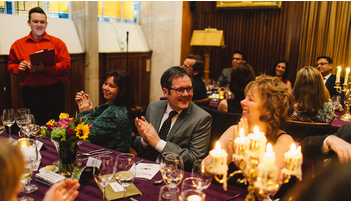I am so honored and privileged to be hosting my third Nonprofit Blog Carnival. On May 4th, I published a “call for submissions” aimed at non-profit and fundraising bloggers that piggybacked on Katherine Fulton’s 2007 TED Talks presentation titled “You Are the future of philanthropy“. You are invited to click-through to view that presentation before checking out what this month’s bloggers submitted (this would be like going to the cotton candy stand before getting on the roller coaster at your local carnival. LOL).

If you didn’t have time to watch Katherine Fulton’s video (and you’re trying to skip through to the “good stuff”), then just know that she covered lots and lots of ground with regard to the future of philanthropy including:
- A new generation of citizen leaders
- The democratization of philanthropy
- Mass collaboration
- Online Philanthropy Marketplaces
- Aggregated Giving
- Innovation Competitions
- Social Investing
- The Social Singularity
With such a diversity of topics to tackle, submissions to this month’s Nonprofit Blog Carnival covered lots of ground. The following 14 bloggers all paint an interesting vision of the future, and they put a resounding exclamation mark on Katherine Fulton’s point that we’re all the future of philanthropy albeit in a multitude of ways.
I hope you enjoy this month’s carnival!

Move over Baby Boomer, Gen X and Gen Y donors, here comes Gen Z. Beth Kanter highlights this school-aged generation in Beth’s Blog and challenges some assumptions that this generation is decades away from being philanthropically engaged. I especially love some of the examples of “PhilanthroKids” and their crowdfunding projects.
Jay Love is the co-founder and CEO at Bloomerang as well as the chairman of the AFP Ethics Committee. He blogs about “5 Reasons Why Nonprofits Need Incubators Too,” which speaks to the of democratization of philanthropy and mass collaboration at an organizational level (Many thought-leaders approach this topic from a donor perspective, but Jay adds an interesting angle on this subject by coming at it from an organizational perspective. Very thought provoking!)
Ve Le is the blogger at Nonprofit With Balls and his post “Winter is coming, and the donor-centric fundraising model must evolve” will get people talking this month. He opines that the donor-centric model is great, but there is a danger in focusing too much on donors. We risk underestimating our donors, elevating them and our individual non-profits at the cost of focusing on the community as a whole. The non-profit sector must move from the donor-centric model to the community-centric model unless it wants to freeze and starve to death.
Ever since the #IceBucketChallenge, many donors and non-profits are now trying to integrate social media into their fundraising plans (need we even mention #RedNoseDay?!?). The CauseVox Blog‘s Kat Kuehl provides tips on developing the perfect hashtag for your crowdfunding campaign because you aren’t going viral without an awesome-catchy-unique hashtag. It only feels appropriate to end this summary by saying #AwesomeSauce.
Randy Hawthorne explains to us over at Nonprofit Hub that what’s new in the world of philanthropy is what was once considered old. It’s what we always should be doing for donors—building our tribes (A special thanks to Seth Godin for re-introducing many of us to a tribal way of thinking).
On the Wild Apricot Blog, Lori Halley tells us that philanthropy is changing and change can be hard. But she believes there is a willingness to change and is hopeful that “the new generation of citizen leaders” can optimize the “convergence of forces” to ensure a bright future for philanthropy.
Tony Martignetti, host of Tony Martignetti Nonprofit Radio, interviewed Maria Semple of The Prospect Finder on the growing popularity and value of giving circles and how to tap into them in your community.
Nonprofit Evolution‘s Dani Robbins writes that we are each the future of philanthropy and can all be philanthropists. New technology brings new opportunities, yet relationship building still rules the day. Engage. Ask. Receive. Repeat.
In the digital age, with the pace of change accelerated, Claire Axelrad at Clairification tell us that leadership is about embracing creativity and partnering to solve problems that can’t be solved in silos. This means inspiring others to take a chance with you and, sometimes, transforming your modus operandi.
“The more things change, the more they stay the same.” This quotation is what Ken Goldstein at The Nonprofit Consultant Blog wrestles with as he dissects Katherine Fulton’s TED Talks presentation. At the end of his post, Ken shares four interesting predictions about the future.
It’s tempting for nonprofit organizations to latch on to the latest craze. But sometimes we need to take a step back. Ann Green reports in Ann Green’s Nonprofit Blog that you can find success by giving your donors the personal touch and good old-fashioned relationship building. The future of philanthropy is already here and it is found in how you build your relationships.
American City Bureau (ACB) is one of the country’s oldest fundraising firms, and Daniel Mollsen’s interview with Bob Hotz at “Take Five” reminds fundraising professionals the more that changes (e.g. smart phones, emails, voicemails, virtual meetings, etc) in our field of work, the more we need to work at striving for balance.
Arroyo Fundraising Fluency‘s Kathie Kramer Ryan shares her vision of the future which is focused on major donors and major gifts.
Per my promise to DonorDreams blog subscribers, I focused all of our posts in May on this carnival topic. We videotaped fundraising professionals and donors talking about Katherine Fulton’s vision of the future. Some participants even took part in the “empty picture frame exercise” at the end of Katherine’s presentation. If you have a few additional minutes, I encourage you to click-through and see/hear these touching “from the heart” testimonials:
- Are you the future of philanthropy? Meet Stephen Taylor
- Are you the future of philanthropy? Meet Danielle Ward
- Are You the Future of Philanthropy? Meet Becky Hardekopf
- Are You the Future of Philanthropy? Meet Dan Rich
I need to thank Marissa Garza for videotaping these individuals, and I especially appreciate those who took time out of their busy schedules to work with Marissa on this project. Thank you!!!
Lori Halley at Wild Apricot blog will be next month’s host of the next Nonprofit Blog Carnival. The theme will be “Motivation for the Nonprofit Nation“. She’ll be looking for any posts from bloggers with ideas, stories or tips for motivating non-profit donors, supporters, boards, volunteers, or staff. Click here for more details and how to submit your blog entry for consideration.
As I say at the end of all my blog posts . . .
Here’s to your health! (and try not to eat too much funnel cake at this month’s carnival)
Erik Anderson
Founder & President, The Healthy Non-Profit LLC
www.thehealthynonprofit.com
erik@thehealthynonprofit.com
http://twitter.com/#!/eanderson847
http://www.facebook.com/eanderson847
http://www.linkedin.com/in/erikanderson847


 An event hosted by a nonprofit is often fighting an uphill battle even before the first committee meeting is scheduled. A finite amount of funds and resources are often all that is available to these worthy causes, which makes raising money for cancer research or underprivileged children even more crucial. However, the lack of resources can leave those involved frustrated, overworked and unsure of how to make an event impactful while working under such budgetary conditions.
An event hosted by a nonprofit is often fighting an uphill battle even before the first committee meeting is scheduled. A finite amount of funds and resources are often all that is available to these worthy causes, which makes raising money for cancer research or underprivileged children even more crucial. However, the lack of resources can leave those involved frustrated, overworked and unsure of how to make an event impactful while working under such budgetary conditions. How can you improve our donations?
How can you improve our donations?

 What goals do you hope to achieve with your fundraising campaign? In addition to raising funds, what else do you hope to accomplish: spread awareness, gain new supporters, strengthen relationships, etc. Jot down your goals as this will shed light on the activities that will follow.
What goals do you hope to achieve with your fundraising campaign? In addition to raising funds, what else do you hope to accomplish: spread awareness, gain new supporters, strengthen relationships, etc. Jot down your goals as this will shed light on the activities that will follow. Who is your target market and where can you find them? Are they active online? If so, make sure you have a fundraising website that’s attractive and easy to navigate. Then not only will you want to make sure your message gets broadcast through online channels, but also make sure it’s easy for people to share your message. Use social sharing widgets & post cool imagery and videos that draw people in. Give people an incentive to help you spread the word. Award people who raise the most funds or drive the most traffic to your website. Look to relevant social media groups that are already invested in your cause and may be more likely to give back. Don’t forget about online channels such as online community groups, local email lists, online calendar of events listings, etc. Leverage existing connections by asking them to tap into their networks.
Who is your target market and where can you find them? Are they active online? If so, make sure you have a fundraising website that’s attractive and easy to navigate. Then not only will you want to make sure your message gets broadcast through online channels, but also make sure it’s easy for people to share your message. Use social sharing widgets & post cool imagery and videos that draw people in. Give people an incentive to help you spread the word. Award people who raise the most funds or drive the most traffic to your website. Look to relevant social media groups that are already invested in your cause and may be more likely to give back. Don’t forget about online channels such as online community groups, local email lists, online calendar of events listings, etc. Leverage existing connections by asking them to tap into their networks.